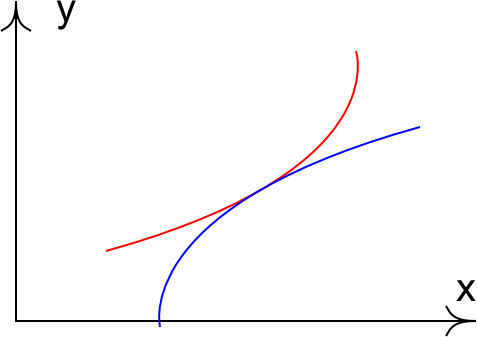|
College Homepage Math Department Course Homepage Homework Announcements Course Calendar Questions/Answers Reference Page |
Reference pageLecture 1 True or not 1. The graph of a solution of y'=f(x,y) is an integral curve. 2. Each integral curve of the direction field of y'=f(x,y) is the graph of a solution (be careful!). 3. The red and blue curves below can not be integral curves of the same direction field.
4. Two integral curves of the same direction field can be tangent as in the picture below.
Answer: The question (4) is difficult. We will discuss it in details later when we learn the Existence and Uniqueness theorem. The Existence and Uniqueness theorem implies that if f and ∂f/∂y are continuous, then different integral curves of the equation y'=f(x,y) can not have common points. Lecture 2 True or not 1. A "first order" differential equation means a differential equation in which the highest derivative is of order 1. 2. If y=y(x) is a smooth function in x, then d/dx(y3)=3y2 dy/dx.
3. Each separable equation is linear. 4. Each linear equation is separable. Lecture 4 Problem 1 Problem 2 Examples 1. Exponential growth: y'=ry y(0)=y0
Solution: y=erty0
Note: The same time period is required to double the population.
Currently for earth population the doubling time is 40 years. Note: Exponential growth is very fast. Virus spreads exponentially, which makes it very dangerous. Example: it is estimated that during 20th century smallpox killed 300-500 million people. 2. Explosion: y'=y2
Solution: y=-1/(t-C)
Note: Here the reproduction rate is proportional to the number of pairs
of individuals. Note: As t approaches C, y tends to infinity, so y becomes infinitely large in finite time. Here the growth is faster than exponential. Note: On the other hand for small t the growth is slow. Example: certain species of whales are having difficulty finding a mate. Their poplulation growth is subject to the above equation. 3. Logistic growth: y'=(r-ay)y
Note: Here the "reproduction rate" r-ay
slows as the population y
increases. Note: The equation was proposed by a Belgiun mathematician P.Verhulst about 200 years ago, who predicted that the population of Belgium will tend to K=9,400,000. Now the population of Belgium is 10,666,866 (2008). 4. Logistic growth with a threshold: y'=-r(1-y/T)(1-y/K)y
Note: Some species bread in large communities and can not bread in
smaller numbers. Example: in 19th century one could see 300-mile-long
flocks of passenger pigeons.
Its number decreased due to hunting. After the threshold T was passed, it was not possible to save them. Lecture 5.5 (x-hour) True or not Existence and Uniqueness Theorem Suppose the functions p(t) and q(t) are continuous. Consider the ODE: y''+ p(t)y' + q(t)y = 0.
1. There is a unique solution (be careful). 2. There are many solutions, one for each pair of initial values (y(t0), y'(t0)). So there is a two parameter family of solutions. 3. The two parameter family of solutions can be written in the form c1y1+
c2y2
where y1, y2 is a fundamental
set of solutions and c1, c2 are parameters
(constants). Wronskian 1. The Wronskian of two functions y1, y2 is defined to be a new function W=y1'y2 - y1y2'
(be careful!)2. If the Wronskian of two functions is zero, then the functions are proportional (careful!) 3. If the functions are proportional, then the Wronskian is zero. 4. If the Wronskian of two solutions is zero, then the solutions are proportional. 5. If the solutions are proportional, then the Wronskian is zero. 6. Two solutions constitute a fundamental set if their Wronskian is non-zero. Lecture 8 Free vibration Forced vibration Millenium Bridge The natural sway motion of people walking caused small sideways oscillation in the bridge, which in turn caused people on the bridge to sway in step, increasing the amplitude of the bridge oscillations and continually reinforcing the effect (from wiki). Tacoma bridge: probably not a resonance Breaking a wine glass Lecture 11 True or not 1. Let f be a smooth function. Then the first k derivatives of f at x=0 are the same as the first k derivatives of the polynomial a0
+ a1x + a2x2
+ a3x3 + ... + akxk
where aj=f(j)(0)/j!Thus we may expect that this polynomial gives a good approximation of f at x=0. 2. The series a0
+ a1x + a2x2
+ a3x3 + ...
where aj=f(j)(0)/j! is
called the Taylor series of f at x=0.
A function is said to be analytic if f equals its Taylor
series. 3. The function f(x)=ex is analytic. Here aj=1/j! The functions cos(x) and sin(x) are also analytic. 4. Consider the function f(x)=e-1/x*x if x is not 0 and f(0)=0. Its Taylor series is convergent (it is zero), but f(x) does not equal its Taylor series. Lecture 14 Systems of linear differential equations: Direction field for systems of linear equations: x'=-y y'=x-y |


